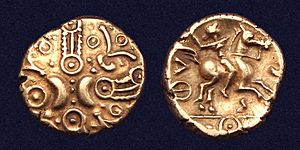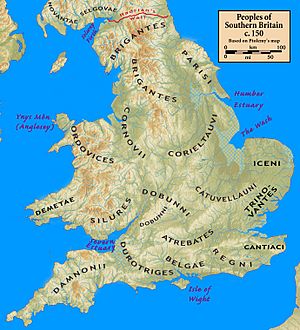Catuvellauni facts for kids
Quick facts for kids Catuvellauni |
|
| Map of the Territory of the Catuvellauni.svg | |
| Geography | |
| Capital | Verulamium (St. Albans) |
|---|---|
| Location | Modern Bedfordshire, Buckinghamshire and Hertfordshire. (Also parts of Berkshire, Cambridgeshire, Essex, Greater London and Oxfordshire.) |
| Rulers | Tasciovanus Cunobeline Caratacus Togodumnus Epaticcus |

Front: stylized crescents and wreaths with hidden faces.
Back: Celtic warrior on horse right, carrying a carnyx (a type of war horn).
The Catuvellauni (say: Cat-oo-vel-AW-nee) were a powerful Celtic tribe in southeastern Britain. They lived there before the Romans took over and are mentioned in writings up to the 4th century.
We know about the Catuvellauni and their kings from old coins and historical records. The writer Cassius Dio said they led the fight against the Roman invasion in AD 43. Later, in the 2nd century, the geographer Ptolemy wrote about them. He said they lived around Verlamion (which is now St Albans) and parts of Hertfordshire, Bedfordshire, and southern Cambridgeshire.
Their land was next to other tribes. To the north were the Iceni and Corieltauvi. To the east were the Trinovantes. The Dobunni and Atrebates were to the west. And to the south were the Regni and Cantiaci.
Contents
What Does "Catuvellauni" Mean?
The name 'Catuvellauni' comes from old Celtic words. Catu- means 'combat' or 'battle'. Uellauni or wellauni means 'chiefs' or 'commanders'. So, the name means 'war-chiefs' or 'chiefs-of-war'. It might be linked to the 'Catalauni' tribe, who lived in modern Champagne, France, during Roman times.
Life Before the Romans Arrived
The Catuvellauni are part of an archaeological group called Aylesford-Swarling. This group is often connected to people from Belgic Gaul (part of ancient France and Belgium). Some historians think this means people from Belgic Gaul actually conquered parts of Britain, as Julius Caesar hinted.
Cassivellaunus was a leader who fought against Julius Caesar when he first came to Britain in 54 BC. Many believe he was a Catuvellauni leader. Caesar didn't say which tribe he belonged to, but Cassivellaunus's land was north of the Thames and west of the Trinovantes. This matches where the Catuvellauni later lived. A large earthwork called Devil's Dyke near Wheathampstead, Hertfordshire, is thought to have been their first capital city.

Tasciovanus was the first king to make coins in Verlamion. He started around 20 BC. He seemed to take over land from the Trinovantes tribe to the east. Some of his coins, made around 15–10 BC, were even minted in their capital, Camulodunum (modern Colchester). He might have given up this land later, possibly because of pressure from Rome. His later coins were made back in Verulamium.
However, Camulodunum was taken back. This happened either by Tasciovanus or his son Cunobelinus. Cunobelinus became king around AD 9 and ruled for about 30 years. We don't know much about his life, but his name became famous in British legends. He even appears in William Shakespeare's play Cymbeline. The writer Geoffrey of Monmouth said Cunobelinus grew up in the court of Augustus (a Roman emperor) and willingly paid taxes to Rome.
Archaeology shows that under Cunobelinus, the Catuvellauni traded more with the Roman Empire. They also had stronger diplomatic ties. Cunobelinus and his family made the Catuvellauni the most powerful tribe in southeastern Britain. His brother Epaticcus took over land to the south and west from the Atrebates tribe. This lasted until Epaticcus died around AD 35. The grave of the "Druid of Colchester" is from this time. It shows us about medical practices and technology used by the Catuvellauni.
Cunobelinus had three sons we know about. Adminius seemed to rule in Kent, based on his coins. He was sent away by his father just before AD 40. This event made the Roman emperor Caligula plan an invasion of Britain, though it didn't happen. Two other sons, Togodumnus and Caratacus, are mentioned by Dio Cassius. We don't have any coins from Togodumnus. But Caratacus's rare coins suggest he finished taking over the Atrebates' lands, just like his uncle Epaticcus.
The Atrebatic king, Verica, was forced to leave his land. This led Emperor Claudius to launch a successful invasion of Britain in AD 43. The Roman general Aulus Plautius led this invasion.
Dio Cassius tells us that Cunobelinus had died by this time. Togodumnus and Caratacus led the first resistance against the Romans in Kent. Plautius defeated them in two important battles on the Medway and Thames rivers. Dio also says that the Bodunni, a tribe who paid tribute to the Catuvellauni, switched sides to the Romans. This might be a mistake for the Dobunni tribe, who lived in Gloucestershire. This could show how far the Catuvellauni's power reached. Togodumnus died soon after the battle on the Thames. Plautius stopped and waited for the emperor. Claudius then led the final advance to Camulodunum. The lands of the Catuvellauni became the center of the new Roman province.
Under Roman Rule
Caratacus, however, survived. He continued to lead the fight against the Roman invaders. We next hear about him from the historian Tacitus. Caratacus was leading the Silures and Ordovices tribes in what is now Wales against the Roman governor Publius Ostorius Scapula. Ostorius defeated him in a big battle in Ordovician land in AD 51. Caratacus's family members were captured, but he escaped again. He fled north to the Brigantes tribe. But their queen, Cartimandua, was loyal to the Romans. She handed Caratacus over in chains.
Caratacus was shown off as a war prize in a victory parade in Rome. He was allowed to give a speech to the Senate. He made such a strong impression that he and his family were set free. They were allowed to live peacefully in Rome.
Verulamium, the Roman town near Verlamion, became a municipium (a town with special rights) around AD 50. This meant its main leaders could become Roman citizens. The town was destroyed during the rebellion led by Boudica in AD 60 or 61. But it was quickly rebuilt. Its forum (a public square) and basilica (a large public building) were finished in AD 79 or 81. They were dedicated by the governor, Gnaeus Julius Agricola, to Emperor Titus. The town's theatre, which was the first Roman theatre in Britain, was built around AD 140.
An old inscription tells us that the Catuvellauni civitas (their local government area) helped rebuild Hadrian's Wall. This was probably during the time of Emperor Septimius Severus in the early 3rd century. Saint Alban, the first British Christian martyr (someone who dies for their beliefs), was a citizen of Verulamium. He was killed there in the late 3rd or early 4th century. The city got its modern name, St Albans, from him. The tombstone of a Catuvellauni woman named Regina was found in a 4th-century Roman fort. She was a freedwoman and wife of Barates, a soldier from Palmyra in Syria. This tombstone was found in Arbeia (modern South Shields) in northeast England.
Leaders of the Catuvellauni
- Cassivellaunus, a military leader, possibly a chieftain, around 54 BC
- Tasciovanus, around 20 BC – AD 9
- Cunobelinus, AD 9 – AD 40
- Togodumnus, AD 40 - AD 43
- Caratacus, AD 43 - around AD 50
See also
- List of Celtic tribes



